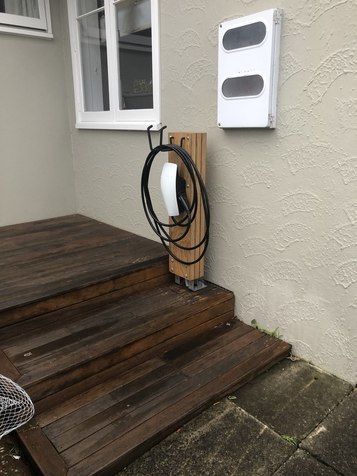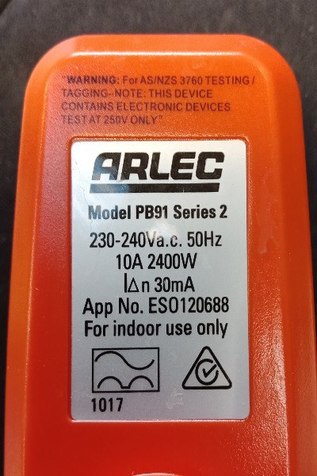-
 Michael Wilson
116I was reading those yesterday. We are starting to service a few electric trucks and are looking at possible electric options in the fleet.
Michael Wilson
116I was reading those yesterday. We are starting to service a few electric trucks and are looking at possible electric options in the fleet. -
 Janene Magson
19Thank you, we were looking for some info as hubby is getting a full electric car from work and a charging station is to be installed at our property
Janene Magson
19Thank you, we were looking for some info as hubby is getting a full electric car from work and a charging station is to be installed at our property -
 Aaron Marshall
118You might also want to verify with your insurance company. Fire protection standards (sprinklers, etc) may not be suitable for a fire involving an EV.
Aaron Marshall
118You might also want to verify with your insurance company. Fire protection standards (sprinklers, etc) may not be suitable for a fire involving an EV. -
 Sheri Greenwell
340My partner and I now both drive electric vehicles. He bought a Tesla charger that would charge both our vehicles (his is a Tesla 3, mine is a BMW i3). He got permission from the landlord to have an electrician install the charger on the rear deck of the house. We had to have an RCD installed to make it safe, and as I understand it (I haven't been directly involved in making the arrangements), part of our set-up included being able to lock the charger when not in use. The entire set-up was certified by the electrician before we could use it. It is a much safer arrangement than trying to charge a vehicle by a plug-in charger sitting on a bedroom windowsill overnight, as well as being very conveniently located in the driveway next to the house.
Sheri Greenwell
340My partner and I now both drive electric vehicles. He bought a Tesla charger that would charge both our vehicles (his is a Tesla 3, mine is a BMW i3). He got permission from the landlord to have an electrician install the charger on the rear deck of the house. We had to have an RCD installed to make it safe, and as I understand it (I haven't been directly involved in making the arrangements), part of our set-up included being able to lock the charger when not in use. The entire set-up was certified by the electrician before we could use it. It is a much safer arrangement than trying to charge a vehicle by a plug-in charger sitting on a bedroom windowsill overnight, as well as being very conveniently located in the driveway next to the house. -
 Steve H
308
Steve H
308
An interesting paper on EV battery fires is available here Somewhat scary when you look at the figures it quotes and pictures of firesYou might also want to verify with your insurance company. Fire protection standards (sprinklers, etc) may not be suitable for a fire involving an EV. — Aaron Marshall
They probably aren't up to speed yet, but certainly a" watch this space" -
 Steve H
308. It is a much safer arrangement than trying to charge a vehicle by a plug-in charger sitting on a bedroom windowsill overnight, as well as being very conveniently located in the driveway next to the house. — Sheri Greenwell
Steve H
308. It is a much safer arrangement than trying to charge a vehicle by a plug-in charger sitting on a bedroom windowsill overnight, as well as being very conveniently located in the driveway next to the house. — Sheri Greenwell
:up: :up: :up: Probably better charging outside, rather than in an internal garage too Sheri
This article on Stuff indicates what can happen EVs Set Fire To Garage -
 Aaron Marshall
118
Aaron Marshall
118
My wife's trying to design a sprinkler system for a building with Lithium Battery storage. That's a whole other area where so far we've just been operating on an 'conveniently overlooked' basis.
But, if you're working on EV's then the risk is somewhat elevated of a short-circuit (dropped tools, etc) and potential toxic fumes, etc. -
 Steve H
308But, if you're working on EV's then the risk is somewhat elevated of a short-circuit (dropped tools, etc) and potential toxic fumes, etc. — Aaron Marshall
Steve H
308But, if you're working on EV's then the risk is somewhat elevated of a short-circuit (dropped tools, etc) and potential toxic fumes, etc. — Aaron Marshall
True Aaron, the deluge requirements are going to be extremely high, given the potential fire heat release of an EV vs ICE with the same battery capacity/ and fuel load is double for the EV.
Which indicates a higher fire risk and mitigation efforts required -
 Aaron Marshall
118And most councils won't give you enough water to run a deluge system.
Aaron Marshall
118And most councils won't give you enough water to run a deluge system.
NFPA have some info regarding first responders, but the Fire Protection research has lagged well behind the pace of technological change. -
 Sheri Greenwell
340Steve - here's the charging station my partner had installed on the rear deck of our house. He carefully made a wooden pedestal, which he treated with a protective oil designed for outdoor marine use and fitted the hooks for hanging the cable. The switch was installed at the side and the charger was wired into the house from the pedestal. You will see that the pedestal stands outside, but it is located where it is pretty well protected from the weather and out of sight.
Sheri Greenwell
340Steve - here's the charging station my partner had installed on the rear deck of our house. He carefully made a wooden pedestal, which he treated with a protective oil designed for outdoor marine use and fitted the hooks for hanging the cable. The switch was installed at the side and the charger was wired into the house from the pedestal. You will see that the pedestal stands outside, but it is located where it is pretty well protected from the weather and out of sight.
Your thoughts?Attachment IMG_8951
(185K)
IMG_8951
(185K)

-
 Steve H
308Looks like a pro job Sheri, I like the idea of charging EV's outside. While the chance of an issue while charging is very, very low, nothing like taking precautions.
Steve H
308Looks like a pro job Sheri, I like the idea of charging EV's outside. While the chance of an issue while charging is very, very low, nothing like taking precautions.
Is there a tally plate on the charger? If it's got a suitable IP rating to be outside it will be fine, I assume he discussed the location with the sparkie that wired it up and the sparkie will have verified the location is OK -
 Sheri Greenwell
340Sorry, Steve, I don't know what a tally plate is.... :-(
Sheri Greenwell
340Sorry, Steve, I don't know what a tally plate is.... :-(
I have not had much to do with this project directly. My partner bought the charger. This is actually our second charger - the first one would charge his Tesla but not my i3, so he sold the first one and bought a different charger. He organised removal of the first charger, installation of the new charger, and coordinated everything along the way with a qualified electrician, who wired the charger in properly under the house and into the board inside the house etc. The electrician advised us when installing the first charger that the charger needed its own RCD, which he installed for us. He then had to sign everything off before we could start using it. We are finding it very handy. -
 Steve H
308Sounds like it's all good,Sheri
Steve H
308Sounds like it's all good,Sheri
The tally plate on an appliance is the little sticker/metal plate that lists what voltage the appliance is safe to use on, it's rated demand (in Watts or Kilowatts), sometimes they will list what Standards the item complies with, if the item is Double Insulated it may say that, or have the Square within a square symbol that indicates it is constructed that way, and if it has an Ingress Protection rating (IP Rating).

This is a tally plate fitted to an RCD plug, if you look at it, starting at the very top there's a note from the maker to any one testing this item to perform a reduced voltage insulation test.
- The plate states who made it : Arlec
- Safe operating voltage :230-240 Volts at a frequency of 50 Herzt
- The current rating, on this item it is the current it can safely carry: 10Amps/ 2400Watts
- The next line tells us this RCD will trip (open) with a current differential of 30mA (30 thousandths of an Amp)
- The next line tells us what this items Electrical Approval number is:ESO120688
- It tells us this item is for indoor use only
- The two symbols at the very bottom tell us that this is a type A RCD (required in NZ for personal protection RCD devices, and the second symbol indicates that it complies with NZ electrical requirements C tick symbol
And a legal requirement to be regarded as "electrically safe to use" under Reg 23 a -
 Sheri Greenwell
340I discovered a Tesla information panel with a QR code.
Sheri Greenwell
340I discovered a Tesla information panel with a QR code.
Thank you - I learned something new today!
Welcome to the Safeguard forum!
If you are interested in workplace health & safety in New Zealand, then this is the discussion forum for you.
More Discussions
- Free stuff
- Guidelines
- Terms of Service
- Useful Hints and Tips
- Sign In
- Created with PlushForums
- © 2025 Safeguard Forum







